Themuleous
Member
First the obligatory safety warning (sorry), this tutorial uses a cylinder pressurised to around 50psi or 3.5 bar. Gas under pressure can be dangerous if not treated with respect. If something goes wrong that’s your fault, not mine. I accept NO responsibility for loss, damage or injury incurred if you use this guide. But be sensible and you shouldn’t have too many problems 🙂
Right, some of you will have seen my pressurised CO2 tutorial based on a fire extinguisher http://ukaps.org/forum/viewtopic.php?f=34&t=266. Well having upped the lighting over my work tank I wanted to add some pressurised CO2, after having realised that yeast CO2 is woefully inadequate and too messy even for my 60lt tank.
I set myself the task of seeing just how cheaply I could put together a pressurised CO2 system and so I’ve come up with the below. Its not perfect and has some quite large ‘cons’ but that should hopefully be balanced by some equally large ‘pros’ and give people on a relatively tight budget the opportunity to try pressurised CO2. I dare say few would go back to yeast 🙂 I also wanted to provide a kit that anyone could get, so all the parts I’ve used I purchased online.
Right first off, the cylinder. This system is based on the disposable 600g CO2 cylinders used for welding. A very cheap place is machine mart, but I dare say you might be able to find cheaper.
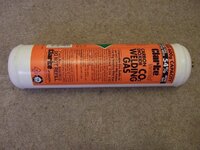
The cylinder is sold with a green cap over the tread, which once removed shows the 1/8 BSPT (British Standard Pipe Thread) thread.
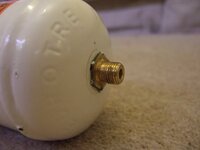
As this is a cheap system I opted for the cheapest regulator I could find, with is a welding regulator with no gauges.
Disposable Draper regulator
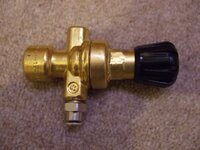
This regulator is supplied with a 4mm OD (outside diameter) push fit connector, which you have to unscrew.
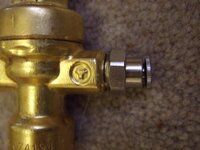
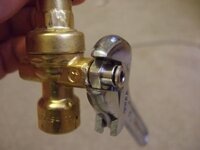

The tricky part of this system was finding a way of converting the 4mm OD push fit adaptor on the regulator to receive 6mm OD CO2 tubing. Then I started to look for pneumatic adaptors and found this one, a 6mm Push in M Stud connector 1/8 BSPT. The ‘1/8 BSPT’ part is the important bit as it determines is the size of the thread 😉 with the ‘6mm’ part the size of the ‘push fit’ connector.
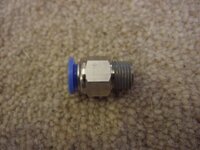
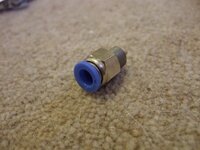
I got it from Simply Pneumatics.
This you then have to screw onto the regulator and tighten using the wrench. As you can probably see it is supplied with a plastic coating on the thread. This was also on the connector I removed and I assume ensures an airtight seal that can withstand the pressure.
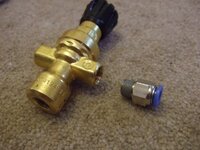
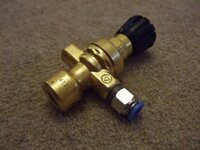
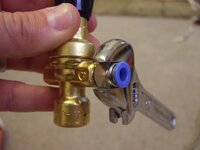
Then screw the adapted regulator onto the cylinder.
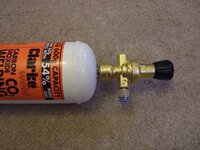
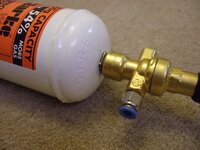
Then ‘push’ one end of the CO2 tubing into the 6mm connector you just added to the regulator. This process required a reassuring bit of pressure and I could feel that it was a good fit. It is after all a pneumatic connector so should cope quite happily with the pressure, one of the advantages of using the connector I have.
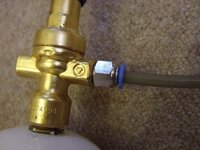
The next hurdle was to incorporate some kind of needle valve to allow the CO2 rate to be controlled. As most will have realised the regulator doesn’t have a needle value built in.
Fortunately our very own AquaticMagic can supply this.
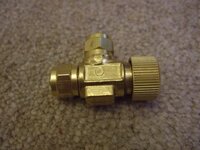
Unscrew both the tubing fixings and add the CO2 tubing, which can be purchased from lots of places but AquaticMagic do that also.
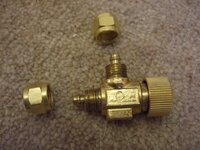

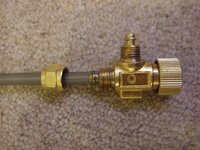

And the same on the other one.
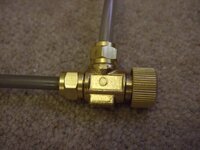
Then all that is left is to add the diffuser, its up to you which you chose, but I like the nano glass diffusers, which I’ve even used on my 250lt tank, so to my mind there is no reason to get anything bigger. I’m also a fan of the cheapo inline diffusers.
Here is the complete system. I dunked the whole thing into my 4ft tank with the regulator fully open and am pleased to say not a single leak 🙂 obviously you could reduce the length of the CO2 tubing to fit as necessary, I just used what I had laying around.
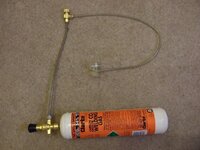
Right to costs, all the below costs include postage where applicable.
600g CO2 cylinder - Machine Mart - £15.41 (£4.50 of this is postage, obvious cost savings if you order several cylinders at once or are able to visit a shop if there is one near you.)
Regulator for disposable cylinders - eBay - £19.99
6mm Push in M Stud connector 1/8 BSPT - eBay - £1.80
Needle value - eBay - $13.40 USD (equaled £8.34 GBP at time of buying)
CO2 tubing - eBay - £2.92
Diffuser - eBay - £4.97 (for two! And two suction cups!)
Total = £53.43
Right pros and cons
Pros = Cheap 😉 available to everyone who can buy stuff online (ok an obvious point but I think an important one), easy to set up (would take less than 5 minutes once you get all the parts), easily adaptable to add extra parts such as a solenoid or even an adaptor that allows you to use refillable cylinders and/or fire extinguishers.
Cons = main one is that is doesn’t have any gauges, so you’ll not know when the CO2 is about to run out, but as this was really an exercise in being a cheapskate I went for the gaugeless regulator. I will just make a note of when the cylider runs out and put a memo in my phone to remind me to replace it before the next one runs out. There are regulators for disposable cylinders that have either one or two gauges but these cost a fair bit more. 600g cylinders will also limit the size of tank you could reasonably use it on. Currently this is on my 60lt tank but I reckon could be used on tanks up to 100lt without using the CO2 at a stupid rate, which hopefully makes it suitable for most tanks.
As a final word, I happened to have laying around a busted lunapet regulator, which Andy (Supercoley) said the needle value could be unscrewed and used in place of the 1/8 6mm adaptor above.
This has the added advantage of having a needle value built in. You can buy these separately, but I could only source these from Germany and the postage cost made this option just too costly. But if you want an ‘all-in-one’ solution its worth remembering, a bit of searching and you might find it cheaper.
EDIT - this has been suggested as a replacement for the push fit connector and as it has a needle value built it removes the need for the co2 hosting between the reg and needle value. I've not tried it but it would make the whole system a lot simpler.
http://www.hosefit.co.uk/catalog/produc ... cts_id=778
I hope this is of help to some people.
Sam
EDIT - 2/2/2011
Following some recent threads I've found that Lunapet post a needle value to the UK for just 2 euro's. So you can have the co2 tubing connector and needle value built into the same attachment and for aorund £10. This is the one I've mentioned later on in the this thread and I've used in my system 🙂
http://cgi.ebay.co.uk/Feinnadelventil-N ... 20addf0baf
Right, some of you will have seen my pressurised CO2 tutorial based on a fire extinguisher http://ukaps.org/forum/viewtopic.php?f=34&t=266. Well having upped the lighting over my work tank I wanted to add some pressurised CO2, after having realised that yeast CO2 is woefully inadequate and too messy even for my 60lt tank.
I set myself the task of seeing just how cheaply I could put together a pressurised CO2 system and so I’ve come up with the below. Its not perfect and has some quite large ‘cons’ but that should hopefully be balanced by some equally large ‘pros’ and give people on a relatively tight budget the opportunity to try pressurised CO2. I dare say few would go back to yeast 🙂 I also wanted to provide a kit that anyone could get, so all the parts I’ve used I purchased online.
Right first off, the cylinder. This system is based on the disposable 600g CO2 cylinders used for welding. A very cheap place is machine mart, but I dare say you might be able to find cheaper.

The cylinder is sold with a green cap over the tread, which once removed shows the 1/8 BSPT (British Standard Pipe Thread) thread.

As this is a cheap system I opted for the cheapest regulator I could find, with is a welding regulator with no gauges.
Disposable Draper regulator

This regulator is supplied with a 4mm OD (outside diameter) push fit connector, which you have to unscrew.



The tricky part of this system was finding a way of converting the 4mm OD push fit adaptor on the regulator to receive 6mm OD CO2 tubing. Then I started to look for pneumatic adaptors and found this one, a 6mm Push in M Stud connector 1/8 BSPT. The ‘1/8 BSPT’ part is the important bit as it determines is the size of the thread 😉 with the ‘6mm’ part the size of the ‘push fit’ connector.


I got it from Simply Pneumatics.
This you then have to screw onto the regulator and tighten using the wrench. As you can probably see it is supplied with a plastic coating on the thread. This was also on the connector I removed and I assume ensures an airtight seal that can withstand the pressure.



Then screw the adapted regulator onto the cylinder.


Then ‘push’ one end of the CO2 tubing into the 6mm connector you just added to the regulator. This process required a reassuring bit of pressure and I could feel that it was a good fit. It is after all a pneumatic connector so should cope quite happily with the pressure, one of the advantages of using the connector I have.

The next hurdle was to incorporate some kind of needle valve to allow the CO2 rate to be controlled. As most will have realised the regulator doesn’t have a needle value built in.
Fortunately our very own AquaticMagic can supply this.

Unscrew both the tubing fixings and add the CO2 tubing, which can be purchased from lots of places but AquaticMagic do that also.




And the same on the other one.

Then all that is left is to add the diffuser, its up to you which you chose, but I like the nano glass diffusers, which I’ve even used on my 250lt tank, so to my mind there is no reason to get anything bigger. I’m also a fan of the cheapo inline diffusers.
Here is the complete system. I dunked the whole thing into my 4ft tank with the regulator fully open and am pleased to say not a single leak 🙂 obviously you could reduce the length of the CO2 tubing to fit as necessary, I just used what I had laying around.

Right to costs, all the below costs include postage where applicable.
600g CO2 cylinder - Machine Mart - £15.41 (£4.50 of this is postage, obvious cost savings if you order several cylinders at once or are able to visit a shop if there is one near you.)
Regulator for disposable cylinders - eBay - £19.99
6mm Push in M Stud connector 1/8 BSPT - eBay - £1.80
Needle value - eBay - $13.40 USD (equaled £8.34 GBP at time of buying)
CO2 tubing - eBay - £2.92
Diffuser - eBay - £4.97 (for two! And two suction cups!)
Total = £53.43
Right pros and cons
Pros = Cheap 😉 available to everyone who can buy stuff online (ok an obvious point but I think an important one), easy to set up (would take less than 5 minutes once you get all the parts), easily adaptable to add extra parts such as a solenoid or even an adaptor that allows you to use refillable cylinders and/or fire extinguishers.
Cons = main one is that is doesn’t have any gauges, so you’ll not know when the CO2 is about to run out, but as this was really an exercise in being a cheapskate I went for the gaugeless regulator. I will just make a note of when the cylider runs out and put a memo in my phone to remind me to replace it before the next one runs out. There are regulators for disposable cylinders that have either one or two gauges but these cost a fair bit more. 600g cylinders will also limit the size of tank you could reasonably use it on. Currently this is on my 60lt tank but I reckon could be used on tanks up to 100lt without using the CO2 at a stupid rate, which hopefully makes it suitable for most tanks.
As a final word, I happened to have laying around a busted lunapet regulator, which Andy (Supercoley) said the needle value could be unscrewed and used in place of the 1/8 6mm adaptor above.
This has the added advantage of having a needle value built in. You can buy these separately, but I could only source these from Germany and the postage cost made this option just too costly. But if you want an ‘all-in-one’ solution its worth remembering, a bit of searching and you might find it cheaper.
EDIT - this has been suggested as a replacement for the push fit connector and as it has a needle value built it removes the need for the co2 hosting between the reg and needle value. I've not tried it but it would make the whole system a lot simpler.
http://www.hosefit.co.uk/catalog/produc ... cts_id=778
I hope this is of help to some people.
Sam
EDIT - 2/2/2011
Following some recent threads I've found that Lunapet post a needle value to the UK for just 2 euro's. So you can have the co2 tubing connector and needle value built into the same attachment and for aorund £10. This is the one I've mentioned later on in the this thread and I've used in my system 🙂
http://cgi.ebay.co.uk/Feinnadelventil-N ... 20addf0baf



